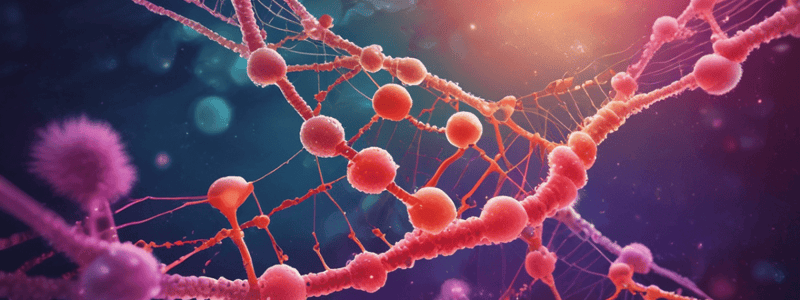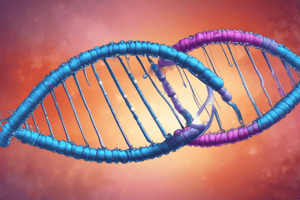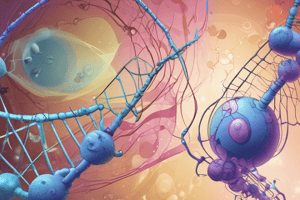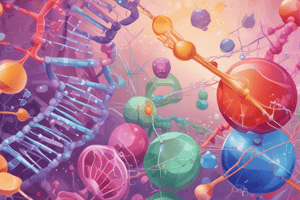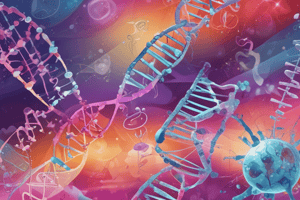Podcast
Questions and Answers
What is the main focus of the lecture on Cancer Chemotherapeutic Agents?
What is the main focus of the lecture on Cancer Chemotherapeutic Agents?
- Detailing the mechanism of action of DNA intercalating agents
- Discussing the therapeutic properties of reductively activated anticancer agents (correct)
- Exploring the DNA of mitomycin C
- Understanding the vascular network of tumor tissue
Why do areas of hypoxia and necrosis often develop in tumor tissue?
Why do areas of hypoxia and necrosis often develop in tumor tissue?
- Tumor cells receive adequate nutrient and oxygen supply
- Normal tissue vessels are far apart
- Vasculature in tumors is hierarchically organized
- Tumor cells are chaotic and have sluggish blood flow (correct)
Which characteristic distinguishes normal vasculature from tumor vasculature?
Which characteristic distinguishes normal vasculature from tumor vasculature?
- Dilated and tortuous vessels (correct)
- Close proximity to blood vessels
- Adequate nutrient supply to all cells
- Hierarchical organization
What is the significance of DNA intercalating agents in cancer treatment?
What is the significance of DNA intercalating agents in cancer treatment?
Which type of anticancer agents are reductively activated, such as mitomycin C?
Which type of anticancer agents are reductively activated, such as mitomycin C?
What structural units are present in Mytomycin C?
What structural units are present in Mytomycin C?
Which type of cancer is porfiromycin in phase III trials for according to the text?
Which type of cancer is porfiromycin in phase III trials for according to the text?
What is the main limitation mentioned in the text regarding the effectiveness of Mitomycin C and similar compounds?
What is the main limitation mentioned in the text regarding the effectiveness of Mitomycin C and similar compounds?
What is the active species formed after the reduction of Mitomycin C?
What is the active species formed after the reduction of Mitomycin C?
How does Mitomycin C react with DNA according to the text?
How does Mitomycin C react with DNA according to the text?
What is the mechanism of action of Mytomycin C's indole derivative?
What is the mechanism of action of Mytomycin C's indole derivative?
Which structural feature is most common in compounds like Mitomycin C?
Which structural feature is most common in compounds like Mitomycin C?
Which type of bonding is primarily responsible for the stabilization of the intercalated complex of doxorubicin with DNA?
Which type of bonding is primarily responsible for the stabilization of the intercalated complex of doxorubicin with DNA?
Which of the following processes does doxorubicin NOT participate in to cause DNA damage?
Which of the following processes does doxorubicin NOT participate in to cause DNA damage?
Which of the following factors contributes to doxorubicin-induced cardiotoxicity?
Which of the following factors contributes to doxorubicin-induced cardiotoxicity?
Which of the following statements best describes dexrazoxane in relation to doxorubicin-induced cardiotoxicity?
Which of the following statements best describes dexrazoxane in relation to doxorubicin-induced cardiotoxicity?
Which enzyme is involved in the conversion of H2O2 to water and oxygen in the presence of dexrazoxane?
Which enzyme is involved in the conversion of H2O2 to water and oxygen in the presence of dexrazoxane?
Which of the following does NOT contribute to the mechanism of action of doxorubicin in treating cancer?
Which of the following does NOT contribute to the mechanism of action of doxorubicin in treating cancer?
What is a common structural feature of mitomycin analogs designed for activity in nonhypoxic cells?
What is a common structural feature of mitomycin analogs designed for activity in nonhypoxic cells?
Which compound is exemplified by KW-2149, known to cause interstrand DNA cross-links and DNA–protein cross-links?
Which compound is exemplified by KW-2149, known to cause interstrand DNA cross-links and DNA–protein cross-links?
What is the process through which DNA intercalating agents interact with DNA?
What is the process through which DNA intercalating agents interact with DNA?
What is the term used to describe the perpendicular insertion of aromatic ring systems between DNA base pairs?
What is the term used to describe the perpendicular insertion of aromatic ring systems between DNA base pairs?
Mitoxantrone is more efficient as a DNA intercalator due to its interaction with which part of the DNA?
Mitoxantrone is more efficient as a DNA intercalator due to its interaction with which part of the DNA?
Which type of interactions stabilize the complex formed between a DNA intercalating drug and DNA?
Which type of interactions stabilize the complex formed between a DNA intercalating drug and DNA?
What structural characteristic makes cationic species more efficient DNA intercalators?
What structural characteristic makes cationic species more efficient DNA intercalators?
Which molecules are typically distorted by the insertion of DNA intercalators between base pairs?
Which molecules are typically distorted by the insertion of DNA intercalators between base pairs?
What specific structural changes induced by DNA intercalation interfere with the function of DNA-associated proteins?
What specific structural changes induced by DNA intercalation interfere with the function of DNA-associated proteins?
What term best describes the process where DNA undergoes a conformational change involving an increase in vertical separation between base pairs upon intercalation?
What term best describes the process where DNA undergoes a conformational change involving an increase in vertical separation between base pairs upon intercalation?
